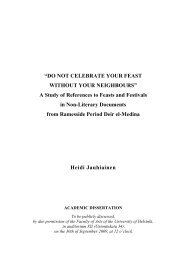BIA
bia51
bia51
Create successful ePaper yourself
Turn your PDF publications into a flip-book with our unique Google optimized e-Paper software.
MAI 2015<br />
été bâtie l’église. « Ces trois premiers niveaux<br />
étaient inondés avant la restauration », reprend<br />
Mustafa. L’eau a été pompée puis les pierres et<br />
les murs ont été nettoyés. Un nouvel éclairage<br />
a été installé, en plus d’un système antiincendie.<br />
Jeudi 7 mai 2015<br />
La restauration architecturale a été menée<br />
par des entrepreneurs égyptiens, tandis que les<br />
finitions et les rénovations minutieuses ont été<br />
opérées par des restaurateurs grecs.<br />
At a seminar organized by the Engineers<br />
Syndicate, ‘Abd al-Halîm Nûr al-Dîn, an expert<br />
in archaeology, said 96 percent of Egypt’s<br />
ancient monuments are neglected and can be<br />
easily stolen or vandalized. He added that the<br />
buildings in the Pyramids Plateau and the area<br />
from al-Rimâya Square until the Fayyûm Road<br />
are encroachments on archaeological sites.<br />
La coupole centrale ornée de la représentation du Christ.<br />
(Photo : Doaa Elhami)<br />
Le premier niveau, celui des fondations de<br />
la tour, renferme les tombes des deux martyrs<br />
grecs, Gabriel et Kyrmidolès. Ce niveau<br />
comprend une petite chapelle, ainsi qu’une<br />
église dont les vitraux représentent le Christ et<br />
la Vierge. « Toutes ces icônes ont été<br />
restaurées par les Grecs sous notre<br />
supervision », se félicite Mustafa. Le deuxième<br />
niveau comprend des poteries et des<br />
céramiques importées d’Iraq et de Syrie. Ce<br />
niveau comprend aussi une église grecque.<br />
Quant au troisième niveau, il est consacré aux<br />
habits et aux outils ecclésiastiques : encens,<br />
croix de fer et en argent incrustées de pierres<br />
précieuses…<br />
L’église Saint-Georges, dans sa forme<br />
actuelle, s’apparente à un complexe religieux.<br />
Mais elle n’est qu’un exemple de lieu de culte<br />
que renferme le Vieux-Caire. L’église cohabite,<br />
en effet, avec une mosquée et une synagogue,<br />
toutes proches. « C’est le reflet concret de la<br />
coexistence des divers cultes et religions »,<br />
conclut ‘Abd al-Rahmân. (Doaa Elhami, « Saint-<br />
Georges, l’église et la forteresse », Al-Ahram<br />
Hebdo du 6 mai 2015).<br />
- -<br />
“Antiquities are not a priority for decisionmakers<br />
in Egypt,” he said, noting that the<br />
scientific advisors have noted include<br />
archaeologists. “And all that people are<br />
interested in is whether it was the Jews who<br />
built the pyramids.”<br />
“Sixty artifacts were stolen from the<br />
Egyptian Museum, in addition to many other<br />
pieces from the museums of Qantara, Mît<br />
Rahîna and Mallawî,” he said. “And there are<br />
300 acres of the archaeological area in Abû Sîr<br />
from which artifacts were stolen.”<br />
He said Israel stole 45,000 artifacts from<br />
Sinai during the occupation, of which 38,000<br />
were repatriated in the 1990s. “They wanted to<br />
keep four particular pieces, but I refused and<br />
told them only the Egyptian people have the<br />
right to dispose of them,” he said. “There are<br />
neglected archaeological sites in Ma‘âdî, Hilwân,<br />
Imbâba, Gîza, Memphis and Old Cairo,” he said.<br />
For his part, Syndicate Chairman Târiq al-<br />
Nabarâwî said he couldn’t understand why the<br />
historical house of President Nâsir has also<br />
been neglected, despite its great political and<br />
historical value. (“Seminar: 96% of Egypt’s<br />
ancient monuments neglected”, Egypt<br />
Independent, May 7, 2015. Voir également Âyâ<br />
Di‘bis, « Nûr al-Dîn : 96 % des antiquités<br />
égyptiennes sont exposées au pillage », al-<br />
Yawm al-Sâbi‘, 6 mai).<br />
<strong>BIA</strong> LI — Janvier/Juin 2015 111



